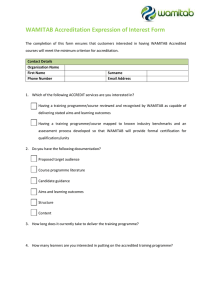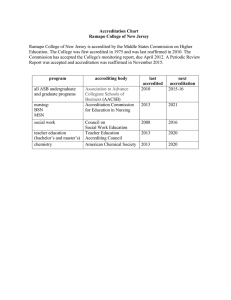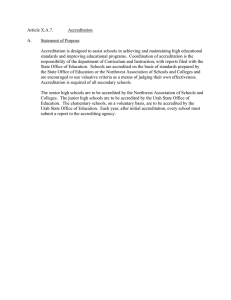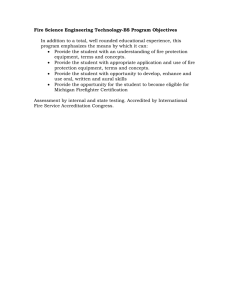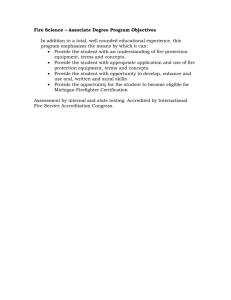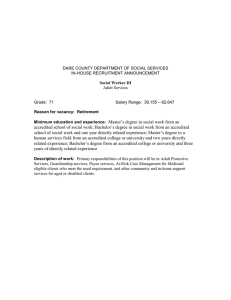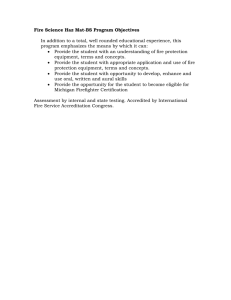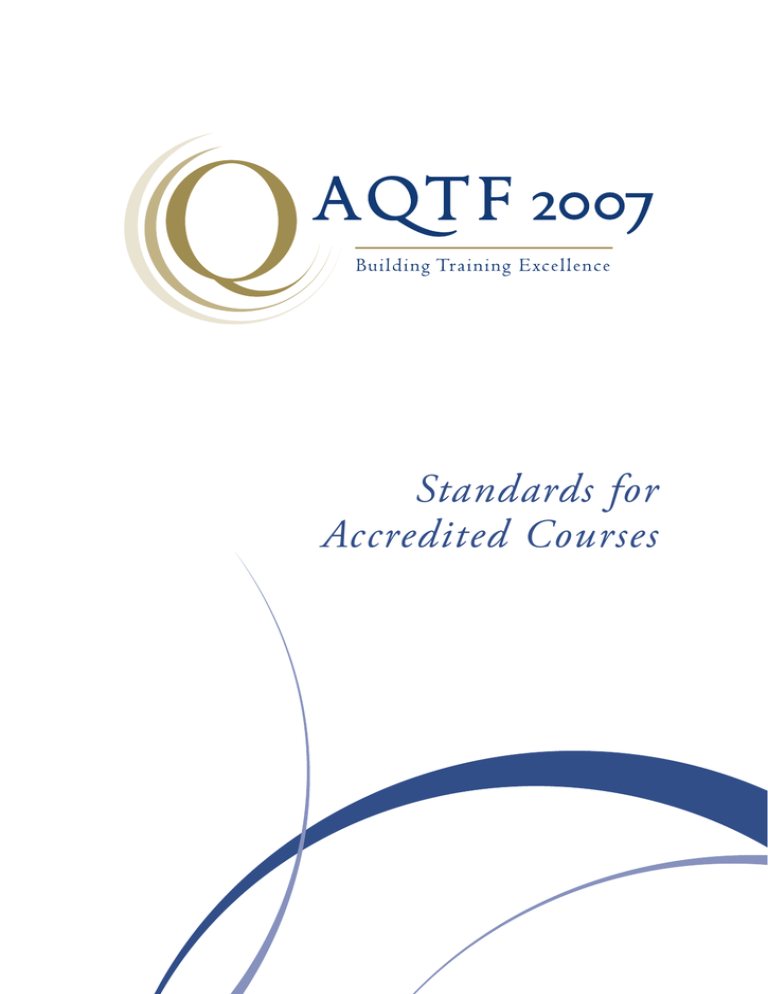
Standards for
Accredited Courses
© Commonwealth of Australia October 2007
This work is copyright. It may be reproduced in whole or in part for study or training purposes,
subject to the inclusion of an acknowledgement of the source and provided that it is not used
for commercial use or sale. All rights are reserved. Reproduction for purposes other than those
indicated above requires prior written permission from the Commonwealth. Requests and enquiries
concerning reproduction and copyright should be addressed to the Branch Manager, Technology
and Information Services Branch, Industry Skills Development Group, Department of Education,
Science and Training, GPO Box 9880, Canberra City, ACT, 2601.
Introduction
Accredited courses address skill requirements for industry, enterprises and the community where these are
not covered in nationally endorsed Training Packages. They also have the capacity to address changes in skill
needs, and the needs of emerging and converging industries and industry sectors, in a responsive manner. A
collaborative approach between national bodies concerned with the development and endorsement of national
training packages and course accrediting bodies provides an effective and timely response to the changing
needs of industry.
Accreditation means the formal recognition of a course by a course accrediting body in accordance with
the AQTF 2007 Standards for State and Territory Course Accrediting Bodies and the AQTF 2007 Standards for
Accredited Courses.
Purpose of the Standards
The AQTF 2007 Standards for �������������������
Accredited Courses� apply to the course design for vocational education and
training (VET) accredited courses.
Accreditation of a course is confirmation by a course accrediting body that the course:
•
meets industry, enterprise or community needs
•
provides appropriate competency outcomes and a satisfactory basis for assessment
•
meets national quality assurance requirements
•
is aligned to the appropriate level of the Australian Qualifications Framework where it leads to
a qualification.
Accreditation means the course is nationally recognised and that a registered training organisation (RTO) can
issue a nationally recognised qualification or Statement of Attainment following its full or partial completion.
Once a course has been accredited, it is listed on the National Training Information Service by the course
accrediting body.
Development of accredited courses should be consistent with the requirements of the Training Package
Development Handbook.
A national template for course accreditation at Appendix 1 describes essential course information and
provides the legal specification for the course. The accredited course document provides the basis for the
development of strategies for training and assessment by each RTO and describes essential course information
including the packaging rules, outcomes to be achieved, standards for assessment and required resources.
St a n d a rd s fo r Acc re d i t e d Co u rs e s
Standards For Accredited Courses
These are the course design standards that must be met for accreditation.
Applications for course accreditation that are accepted by a course accrediting body will be accredited if they
are assessed as meeting the following design standards. A users' guide providing guidance to course owners on
course development processes and the interpretation of the standards is available at (www.training.com.au/
aqtf2007).
Applications for course accreditation will not be accredited if the course duplicates, by title or coverage, the
outcomes of an endorsed Training Package qualification.
Accredited courses:
1. are based on an established industry, enterprise, education, legislative or community need.
2.
are based on nationally endorsed units of competency where these are available and where these are not
available the course is based on:
• units of competency developed as part of the course
or
• modules.
These units of competency or modules are developed in consultation with, and validated by, appropriate
industry, enterprise, community and/or professional groups and documented in accordance with
nationally agreed specifications, consistent with the requirements of the Training Package Development
Handbook.
ote: Modules may be included where the copyright owner can establish to the satisfaction of the course
N
accrediting body, prior to development, that it is not possible to develop appropriate competency standards.
3.
either:
a) lead to a qualification and have course outcomes that are consistent with the Australian
Qualifications Framework qualification descriptor identified for the course
or
b) lead only to a Statement of Attainment when course outcomes meet an identified industry/enterprise/
community need but do not have the breadth and depth required for a qualification as stated in the guidelines for qualifications in the Australian Qualifications Framework. The course title will read ­
'Course in...'.
4.
identify employability skills relevant to the course outcomes.
5.
confirm recognition to be given to the course by licensing, regulatory, professional or industry bodies where applicable.
6.
specify rules for the structure of the course.
Standards for Accredited Courses
7.
identify exit points from the course which provide for vocational or educational outcomes where applicable.
8.
provide information on educational pathways and articulation where applicable.
9.
specify any entry requirements to the course and justify any explicit limitations to access.
10. specify course assessment strategies, which:
•
are valid, reliable, flexible and fair
•
support the collection of evidence that is sufficient, valid, authentic and current
•
are consistent with the assessment guidelines in the relevant Training Package(s) where nationally
endorsed units of competency are used
•
ensure that workplace and regulatory requirements, where relevant, are met
•
identify and justify any requirements for workplace and/or simulated assessment.
11.provide guidance on appropriate delivery modes, together with advice on limitations on course delivery
modes and any requirements for on-the-job training.
12.specify specialist facilities and resources and the vocational competency requirements of trainers and
assessors essential for the delivery of the course.
13. identify course monitoring and evaluation processes which will ensure that the course content and
outcomes are reviewed and remain current and relevant throughout the period of accreditation.
Obligations of course copyright owners
The following obligations apply throughout the course accreditation period.
The copyright owner will:
•
monitor and evaluate the course in accordance with the processes outlined in the accredited course document
•
inform the state or territory course accrediting body of any proposed significant changes to the course
and, if required, provide any relevant material to enable the state or territory course accrediting body to
confirm that the course remains current and relevant and that it continues to comply with the AQTF 2007
Standards for Accredited Courses during the period of accreditation
•
advise RTOs licensed/franchised to deliver the course of changes made as the result of course
monitoring and evaluation
•
not make any misleading statement regarding its accredited course
•
if required, participate in strategic evaluations initiated by the state or territory course accrediting body
as part of the continuous improvement cycle of the National Skills Framework (NSF).
St a n d a rd s fo r Acc re d i t e d Co u rs e s
Appendix 1
Template for course documentation for accreditation
This national template is designed to assist in the development of courses for accreditation and
re-accreditation under AQTF 2007 that lead to an AQF qualification or to a Statement of Attainment. The
template is divided into three sections (A, B and C) which together form the course documentation.
The course document (Sections A, B and C) is the legally recognised specification for the course. It provides
the basis for the development of strategies for training and assessment by each RTO and describes essential
course information.
• Section A provides information about copyright and course classification
•Section B contains details of industry need, and the rules under which the course may be accessed,
delivered and assessed
• Section C includes the units of competency or modules that are contained in the course.
Standards for Accredited Courses
Section A: Copyright and course classification information
1. Copyright owner of the course
Provide the name of the legal entity or individual who owns
copyright of the course(s) being submitted for accreditation. Provide
both the ongoing organisational contact details and the day to day
contact details where these are different.
2. Address
Provide street, postal and email address of the legal entity or
individual that is the copyright owner.
3. Type of submission
State whether the submission is for accreditation or re-accreditation.
4. Copyright acknowledgement
Ensure copyright approval for any units or modules not owned
by your organisation. Commonwealth owned materials such as
Training Packages are licenced under the Free Education licence.
Details are available at www.aesharenet.com.au/FfE2
Indicate if this course may be used under licence or franchise and
if relevant state requirements for use by other providers. Provide
contact details for these arrangements.
5. Licencing and franchise
6. Course accrediting body
Provide the name of the state or territory course accrediting body
responsible under legislation.
7. AVETMISS information
Provide AVETMISS classification codes that describe the industry,
occupational group and field of education for which the course is intended.
ASCO code
Insert code and
(Australian Standard Classification
description
of Occupations – occupational type
To be replaced by ANZSCO [Australian
and New Zealand Standard Classification
of Occupations])
8. Period of accreditation
St a n d a rd s fo r Acc re d i t e d Co u rs e s
ASCED Code – 4 digit
(Field of education)
Insert code and
description
National course code
To be provided
by the course
accrediting
body once the
course is accredited
[Classification codes for AVETMISS data may be found on the
NCVER website at www.ncver.edu.au ]
Include details of the requested period of accreditation.
Accreditation dates will be confirmed by the course accrediting body
once the course is accredited.
Section B: Course information
1. Nomenclature
Standard 1 for Accredited Courses
1.1 Name of the qualification
State the name(s) of the qualification(s) that will be awarded on
successful completion of the course.
1.2 Nominal duration of the State the nominal duration of the course(s) in hours.
course
2. Vocational or educational Standard 1 for Accredited Courses
State the intended purpose of the course.
outcomes of the course
3. Development of the course Standards 1 and 2 for Accredited Courses
3.1 Industry /enterprise/
community needs
Provide evidence of industry/ enterprise/community need and
support for the course and describe the consultation and validation
process.
Identify the major client and/or industry groups.
Confirm the proposed award is not covered by a qualification within
a Training Package.
3.2 Review for re-accreditation Standards 1 and 2 for Accredited Courses
If applying for re-accreditation, provide details of how monitoring
and evaluation have been taken into account in the revised course.
Detail any transition arrangements from the existing course to the
new course for learners currently enrolled in the existing course.
4. Course outcomes
Standards 1, 2 and 3 for Accredited Courses.
4.1 Qualification level
Describe how the intended course outcomes are consistent with the
proposed AQF qualification proposed for the course.
4.2 Employability skills
Standard 4 for Accredited Courses
Provide a summary of the employability skills to be achieved in the
course. If the course only leads to a Statement of Attainment (e.g.
Course in), this is optional.
4.3 Recognition given to the Standard 5 for Accredited Courses
course (if applicable)
State the recognition given to the course(s) by professional or
industry bodies, if applicable , for example by granting membership.
4.4 Licensing/ regulatory
requirements
(if applicable)
Standard 5 for Accredited Courses
State the extent to which the course satisfies licensing/ regulatory
requirements, if applicable.
Standards for Accredited Courses
5. Course rules
Standards 2, 6, 7 and 9 for Accredited Courses
5.1 Course structure
All qualifications identified in the structure must be accredited in
their own right and assigned an NTIS course code.
Course structure may be presented in table format or as a
combination of text and table, including guidance on sequencing,
pre-requisites and nominal hours.
1. Outline the structure of the course and the rules for completion.
Course structure will reflect the intended skill and knowledge
outcomes of the course and may be:
•
•
•
•
•
core only
core and electives
core and specialisations
core, specialisations and electives
electives only
2. Any exit points from the course that provide for vocational or
educational outcomes should be identified.
3. Include a statement that a Statement of Attainment will be
issued for any unit of competency/ module completed if the full
qualification is not completed.
5.2 Entry requirements
Standard 9 for Accredited Courses
Describe entry requirements essential to the course. Wherever
possible, these should be expressed in terms of competencies.
Limitations to entry should be justified.
Recommended entry requirements (including language, literacy and
numeracy skills) that are likely to facilitate successful completion of
the course by the intending participant may also be included.
St a n d a rd s fo r Acc re d i t e d Co u rs e s
6. Assessment
Standard 10 and 12 for Accredited Courses
6.1 Assessment strategy
1. Describe the course assessment strategy in terms of how it
effectively judges participants’ achievement of outcomes. The
strategy should outline the approach to assessment and evidence
gathering to be followed by the RTO, including any mandated and/
or recommended modes of assessment.
2. Describe how assessment of the course will be consistent with
the AQTF 2007 Essential Standards for Registration and identify
course assessment strategies which:
•are consistent with the assessment guidelines in the relevant
Training Package(s) where nationally endorsed units of
competency are used
•ensure that workplace and regulatory requirements, where
relevant, are met
•justify mandatory workplace assessment, or assessment through
simulation if these are to be used and include advice on how
they may be achieved
•identify any special arrangements that may facilitate
Recognition of Prior Learning.
6.2 Assessor competencies
Standard 12 for Accredited Courses
1. Confirm compliance with the requirements for the competence
of staff involved in assessment in the AQTF 2007 Essential
Standards for Registration and provide guidance on the vocational
competency requirements for assessors.
2. Justify any requirements above the requirements in the AQTF
2007 Essential Standards for Registration for the competencies of
assessors.
7. Delivery
Standards 11 and 12 for Accredited Courses
7.1 Delivery modes
1. Identify and justify any delivery modes essential to the delivery of
this course, particularly on-the-job training.
2. Identify and justify any limitations to the delivery modes that
may be chosen for this course.
3. Identify any educational support mechanisms for maximising
participants’ completion of the course.
4. Indicate how the course may be varied to reflect the needs of
learner groups through the contextualisation of units or other
means where appropriate.
Standards for Accredited Courses
7.2 Resources
Standard 12 for Accredited Courses
1. Provide details of specialised facilities and equipment essential for
the delivery of the course.
2. Provide advice on the vocational competency requirements for
trainers. Any requirements above the requirements of the AQTF
2007 Essential Standards for Registration must be justified.
3. Units of competency that have been imported from Training
Packages must reflect the requirements for trainers specified in that
Training Package.
8. Pathways and articulation Standard 8 for accredited courses
1. Provide details of potential pathways for course participants, both
into the course and into other VET and higher education courses on
completion, including details of any formalised articulation and/or
credit transfer arrangements.
2. If this course contains nationally endorsed units of competency,
identify any connections with other Training Package qualifications
that are relevant to vocational pathways for course graduates.
9. Ongoing monitoring
and evaluation
Standard 13 for accredited courses
1. Describe arrangements that the copyright owner proposes to use
for monitoring and evaluating the course to maintain its relevancy
and currency.
2. Confirm that significant changes to the course resulting from
course monitoring and evaluation procedures will be notified to the
course accrediting body.
St a n d a rd s fo r Acc re d i t e d Co u rs e s
Section C: Units of competency
Section C of the course documentation consists of the units of competency making up the course (or
modules, where relevant).
The following must be included:
1. A list of the units of competency imported from Training Package/s
(Note: the title and code of the units must be current and the same as the title and code used in the
Training Package)
And / or
2. The units of competency for the course which comply with the relevant requirements for the Training
Package Development Handbook
Or
3. Modules for the course
(Note: modules may be included where the copyright owner can establish to the satisfaction of the course
accrediting body, prior to development, that it is not possible to develop appropriate competency
standards. A module template is available from the course accrediting body).
10
Standards for Accredited Courses
AQTF 2007 National Publications
State and Territory course accrediting bodies and course developers will use
these documents
AQTF 2007 Standards for State
and Territory Course Accrediting
Bodies
This document is a key tool for state and territory course accrediting bodies to manage
course accreditation under state and territory legislation.
AQTF 2007 Standards for
Accredited Courses
This document specifies the requirements to be met for a course to be accredited.
AQTF 2007 is underpinned by the principle of transparency. All stakeholders in the VET system should have
access to documents detailing the different components of AQTF 2007. All national documents are available
for download from the national website: www.training.com.au/aqtf2007.

